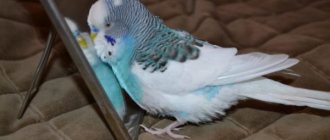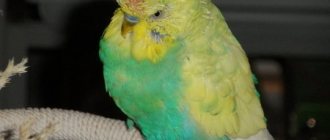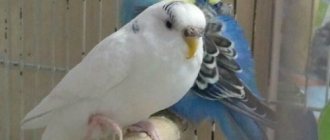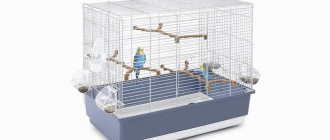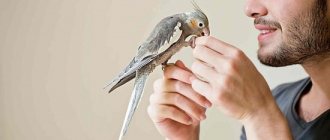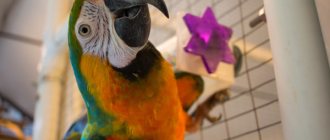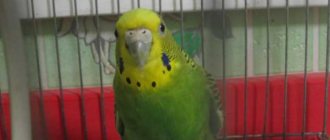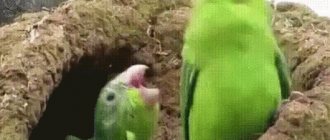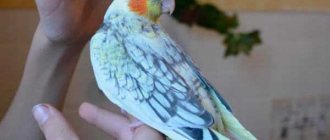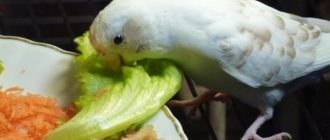Cold
The parrot is a heat-loving bird. If the room temperature drops below +20 degrees, he hides his beak to keep warm. This heat lover should not be kept at low temperatures. A person can be comfortable, but tropical beauties are chilly. This can lead to the development of colds and decreased immunity.
Sudden temperature changes and drafts are also dangerous for overseas beauties. The bird's house should not be placed near a window that is often opened. Even in the hot summer, this negatively affects the health of the pet. In winter, the cage is not kept near a hot radiator. He overheats near her, and then suffers from the temperature difference when he is released to fly.
Is there anything I need to do?
A good owner always notices any changes in the behavior of the wavy. If the bird starts to feather its feathers and behaves very quietly, you can’t just pretend that nothing is happening. This behavior can signal serious health problems, so without treatment and surgical intervention the bird may die.
If the parrot has just been purchased, it will behave warily. After a period of adaptation and getting used to a person, his unique character is revealed. If the parrot suddenly begins to crest, then other symptoms that may signal the presence of a serious disease are initially assessed.
Next, it is recommended to do the following:
- the parrot and the cage, as well as other equipment, are inspected to make sure that the bird has not swallowed a foreign object;
- it is advisable to remember what exactly happened before the bird ruffled its feathers, for example, if there was loud screaming in the house, then such behavior may be associated with stress;
- if two parrots live in one cage, then it is advisable to remove the individual that is behaving suspiciously;
- ensures silence in the room;
- the heat lamp is turned on to warm the bird;
- sorbent or a small amount of chamomile infusion is poured into the beak through a syringe without a needle;
- if during the inspection of the bird wounds or fractures are found, they are treated with an antiseptic and also fixed with a cloth;
- To support your pet's strength, you can give 2 drops of glucose.
Using different actions, you can understand why the parrot changed its behavior. If a bird is frightened and exhausted, it ruffles its feathers. If there are no additional symptoms that indicate the presence of the disease, then you can cope with this situation on your own.
But if the bird does not react, and also develops a cough or diarrhea, then it is recommended that all manipulations be performed only after consultation with a veterinarian.
Stress
Constant boredom or serious changes in the usual life of the handsome winged creature can lead to sudden overexertion. For example, his partner died, the owner or place of residence changed. The cause of stress can be a new, unusual food that your pet doesn’t like. Or the cage was moved to an unfamiliar place, far from all family members. Perhaps there are new noisy animals or small children in the house.
When stressed, a parrot often hides its beak under its wing. At the same time, he becomes lethargic, may pluck himself and eat poorly. You should think about why your winged friend behaves this way and help him. In this state, the bird becomes susceptible to diseases. Depression may develop, which threatens the pet's mental state and can lead to its death.
Why does a parrot cock its feathers?
If a restless budgie has stopped jumping and twittering and sits more and more, with its ruffles and head hidden, this behavior is an alarming signal. This is not always a symptom of illness, but it is obvious that the parrot is cresting due to severe discomfort. In addition to the disheveled appearance, the bird develops a slight chill. She rolls her eyes and opens her beak, breathing heavily. The reasons for such poor health are hidden in the increase in body temperature, which indicates inflammatory processes in the body.
Cold
Delicate ornamental birds are afraid of drafts; even a light summer breeze is harmful to them. A cold is manifested by sneezing, runny nose, and later a cough. The parrot refuses food and sits for a long time, huddled in a ball and with its feathers spread out. Thus, he tries to conserve energy and keep warm. How to help, how to treat if a parrot has been cresting for several days?
First aid:
- Humidify the air. Increased dryness harms the respiratory system, the condition of the bird worsens;
- Let's drink a warm infusion of chamomile with a drop of lemon juice. This drink relieves inflammation and strengthens the immune system;
- Use steam inhalation. Pour crushed chamomile flowers with hot water and place the container near the cage. By inhaling healing air, the bird will stop coughing faster.
If the above methods do not help within one to two days, contact your veterinarian. After a medical examination, it will be clear why the ruffled parrot looks so sick. Perhaps his illness has a more serious origin than a cold.
Internal parasites
Consider this situation: a parrot hides its head under its wing and sleepily ruffles its feathers, although it is still light. He reacts irritably to touch and does not respond to the owner’s voice; he descends onto the tray of the cage, unable to stay on the perch. Most likely, the pet has helminths inside, which take away energy. Intestinal parasites are not uncommon in pets. Helminthiasis greatly complicates the life of birds, and they become infected by eating dirty food. Poor sanitary conditions, lack of disinfection of equipment - and roundworms are right there.
Parasites annoy the bird so much that it has no desire to preen itself. Feathers are constantly ruffled; now tasty food is not a pleasure for the budgerigar. An apathetic attitude, silence and weakness make the pet unrecognizable. Treatment will help restore the joy of life to a parrot that has become ruffled. It is quite difficult to detect helminths on your own, so you need to get tested at a veterinary clinic. There are drugs available that quickly get rid of parasites.
On a note! To prevent re-infection, a thorough cleaning is carried out, and the cage and accessories are disinfected.
Poisoning
It's no secret that parrots love to taste everything around them. Flying around the room, a bird can bite off a leaf of a plant, swallow a piece of newspaper, or steal a pill forgotten on the table. The outcome of such incidents is not always successful. After a free walk, the parrot sits quietly at the bottom of the cage, exhausted, indifferent to everything. Look around, perhaps you will notice some clue as to why the parrot is ruffled.
What can poison a domestic wavy?
- medicines;
- poisonous paint or flowers;
- toxic aerosol;
- resin;
- food from the common table;
- low quality plastic.
Attention! Having found out the cause, you need to act immediately, otherwise the pet’s condition will quickly worsen, even to the point of death. You should give the parrot an enterosorbent to drink, and then take it to the doctor.
Exhausted, lethargic and chilly, why does a parrot become like this? If the pet also suffers from vomiting and diarrhea, we can talk about poisoning with spoiled food. Damp grain left in the feeder quickly becomes moldy. Unripe or rotten fruits cause fermentation in the stomach. Mild intestinal upset usually resolves within a few days.
Lack of personal contact and doing nothing
Scientists have proven that some members of the parrot family have the mental development of a four-year-old child. Sometimes a parrot hides its beak simply because it does not find an outlet for its energy or is bored. In addition, he can chew wallpaper, furniture or walls to attract the attention of the owner. This is especially true for large species.
In the wild, he constantly has to work: get food, hide from enemies, or communicate with other birds. A “potted” bird doesn’t need to do all this, so it has a lot of free time. We need to help the parrot overcome boredom.
- Spend more time with him, talking to him for several hours every day. Talk, stroke, entertain in various ways.
- Allow your pet to fly around the apartment under supervision; you cannot keep it in a cage all the time.
- Buy special toys for birds and change them from time to time.
- Equip the cage with various ropes and swings.
- Buy other parrots of this species.
Sleep rules
Like any living creature, budgies prefer to sleep at night. They do this not under a warm blanket and on a soft bed. Birds prefer to rest on a branch, standing on one leg. This is necessary for proper rest. Young individuals sleep on two legs, this is due to the fact that their coordination is poorly developed and it is difficult for them to maintain balance on one limb.
Even budgerigars, when resting, turn their heads behind their backs and hide their beaks in a feather. This is how birds stay warm throughout their sleep. After a person falls asleep, it is difficult for him to maintain the warmth of his body; a blanket is used to maintain the desired temperature. In domestic parrots, this protection is provided by their own feather.
In their natural environment, budgies also sleep at night. The crown of trees is used for sleeping. The branches create a barrier for predators who want to feast on small birds. During the day they also rest, but this does not last long, 20-30 minutes. Most often, parrots sleep during the hottest hours of the day, hiding in the shade of foliage. For proper rest, a parrot needs to rest 10-15 hours a day.
But poultry's life schedule does not always coincide with human sleep time. For example, with the first rays of the sun, a budgie will also wake up and chirp. Such songs can irritate apartment dwellers. That is why it is recommended to cover the cage with your feathered pet with a dark blanket at night. This way you can simulate night and avoid waking up in the early morning hours.
Causes not related to the disease
If a parrot has a sad ruffle, this does not mean that it is physically ill. The bird is often worried due to some external stimuli. When there are no other manifestations of the disease, short-term chills and frizz are probably caused by fear or cold.
Fear and stress
Budgerigars have a very weak heart and are extremely shy. These birds can be unsettled by loud music, sharply turned on lights, or children running around. When experiencing stress, a budgerigar hides its beak on its back and crests, shrinks, trying to become invisible. His heart is pounding, ready to jump out of his chest. If you notice this behavior, eliminate the irritants, and then calm your pet.
Freezing
In the room where the budgerigar lives, the air temperature must be at least 22 degrees. The heat-loving bird, although covered with dense feathers with down, is very sensitive to low temperatures. This is especially true for those who are going through a molting period. Having frozen, the ruffled parrot hides its beak in the feathers of its back, under its wing. He is half asleep, barely moving, trying to warm up.
Not enough light
Another reason why a parrot often sits with its ruffles is the short daylight hours. In winter, you need to artificially increase the length of the day: turn on an ultraviolet lamp in the evenings. Not only the duration of light exposure is important for the parrot, but also the quality of the light. Birds need vitamin D, and it is produced in the body under the influence of open sun or rays from special devices.
How do budgies sleep?
Let's talk about how budgies sleep.
Sleep is an important part of the life of budgerigars. These are not the birds that can take a nap for a couple of hours and feel great all day long. No, budgies need full sleep, lasting at least 10 hours. What is this connected with? In the wild, budgerigars live in Australia. They have something to do there, find food, escape from enemies, and feed their offspring. But despite all these worries, parrots find time to take a nap even during the day. In the middle of the day, as a rule, there is terrible heat in Australia, and all living things hide in the shadows. Budgerigars are no exception. The whole flock of them sit for hours in the crown of trees. Now we have found out the reason for the daytime and long night sleep of domesticated budgerigars. Their instincts have not disappeared anywhere. So if your budgie allows himself to take a nap during the day, then it’s okay. This is the norm. As I said above, the bird should get a good night's sleep. A little about the positions in which budgies sleep. As a rule, healthy adults sleep on twigs while standing on one leg. Why on one? Try being on your feet all day and still sleeping on them! I won't be wrong if
I will say that standing on one paw, the wavy ripples on the other allow you to rest.
It must be said that not all budgies sleep on one leg; some individuals sleep on two legs. Young animals also mostly sleep on two legs - they still have poor coordination. During sleep, parrots often turn their heads behind their backs and hide their beaks in their feathers. Why is that? Perhaps in this position of the head it is easier to maintain balance at night.
I have always wondered why budgerigars hide their beaks in their feathers. I asked a friend who breeds these birds about this. He explained this fact to me like this. Doctors conducted research and found that when you sleep with the window open in cool weather, the chances of getting sick are several times lower when there is a light curtain hanging on the window. The role of such a curtain in budgerigars is played by their down, through which they breathe at night. Also, during sleep, parrots inflate their feathers and become like koloboks. I think it also allows for better heat retention. I want to give one warning. If you have a bird that is being treated for a broken wing or leg, then temporarily hide all the perches and stepladders. Otherwise, you may fall at night and get injured. Even healthy parrots can fall off their perch at night. Due to our lifestyle, it is not always possible to ensure sufficient sleep for budgerigars. To do this, cover the cage with a light blanket in the evening, leaving the front wall of the cage open. The wavy birds are afraid the first time, but later they will get used to it and know that it’s time to sleep. This blanket will protect you from the morning chirping of birds while you sleep.
If you liked the article about how parrots sleep, please share it with your friends

